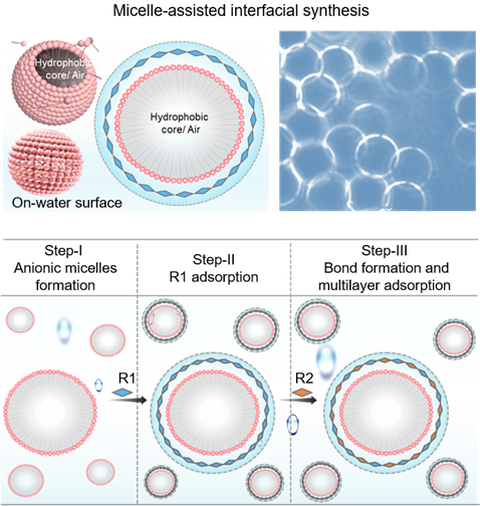Dec 09, 2024
Mimicking on-water surface synthesis through micellar interfaces
The on-water surface is ubiquitous in nature and plays a crucial role in fundamental chemical, biological, and environmental processes, where the water surface or interface uniquely enhances reactivity, enables selective chemistry, and confines molecular geometry, making it a significant platform for advancing chemical synthesis. These exceptional characteristics are now being utilized to develop innovative approaches for sustainable and efficient chemical reactions. However, traditional on-water surface synthesis remains constrained due to the need for a stable air-water interface. Addressing this challenge, researchers from TU Dresden and Max Planck Institute for Microstructure Physics have successfully mimicked the on-water surface chemistry using self-assembled micellar structures.
In this work, self-assembled micellar structures, formed by charged surfactant molecules beyond their critical micelle concentration (CMC). Within these micelles, the hydrophobic cores mimic an air-like environment, while the water layer surrounding the surfactant head groups serves as an interface, replicating the conditions found in on-water surface chemistry. The distinctive confined geometry (J-aggregate) of porphyrin reactant molecules with preferential orientations results in unique reactivity and high selectivity (≥99%) on the micelle surface, as demonstrated in various reversible and irreversible chemical reactions. Notably, the team extended this strategy to synthesize two-dimensional (2D) crystalline polymer thin layers directly in water under ambient conditions. This approach broadens the scope of on-water surface chemistry and provides a scalable platform for a wide range of chemical and material syntheses.
Acknowledgements: This work was financially supported by the EU Graphene Flagship (GrapheneCore3, no. 881603), ERC Consolidator Grant (T2DCP), H2020-MSCA-ITN (ULTIMATE, no. 813036), H2020-FETOPEN (PROGENY, 899205), CRC 1415 (Chemistry of Synthetic Two-Dimensional Materials, no. 417590517), SPP 2244 (2DMP), GRK2861 (no. 491865171), as well as the German Science Council and Center of Advancing Electronics Dresden. The authors acknowledge the Center of Advancing Electronics Dresden and the Dresden Center for Nanoanalysis at TUD.
Reference: Anupam Prasoon, Shaik Ghouse, Nguyen Ngan Nguyen, Hyejung Yang, Alina Müller, Chandrasekhar Naisa, Silvia Paasch, Abdallh Herbawe, Muhannad Al Aiti, Gianaurelio Cuniberti, Eike Brunner and Xinliang Feng*, Mimicking on-water surface synthesis through micellar interfaces. Nat. Commun. 15, 10495 (2024). https://doi.org/10.1038/s41467-024-54962-z

